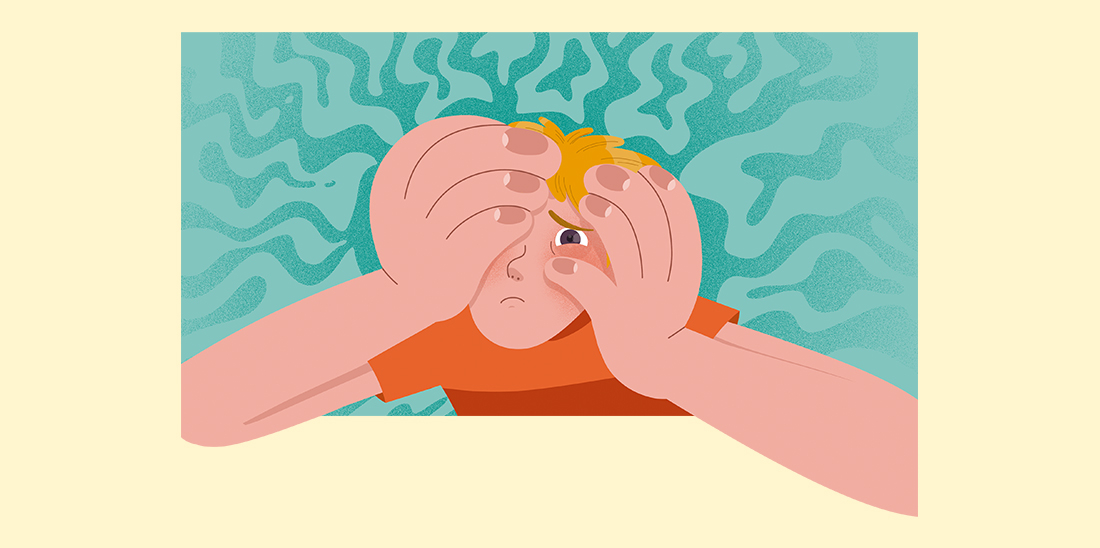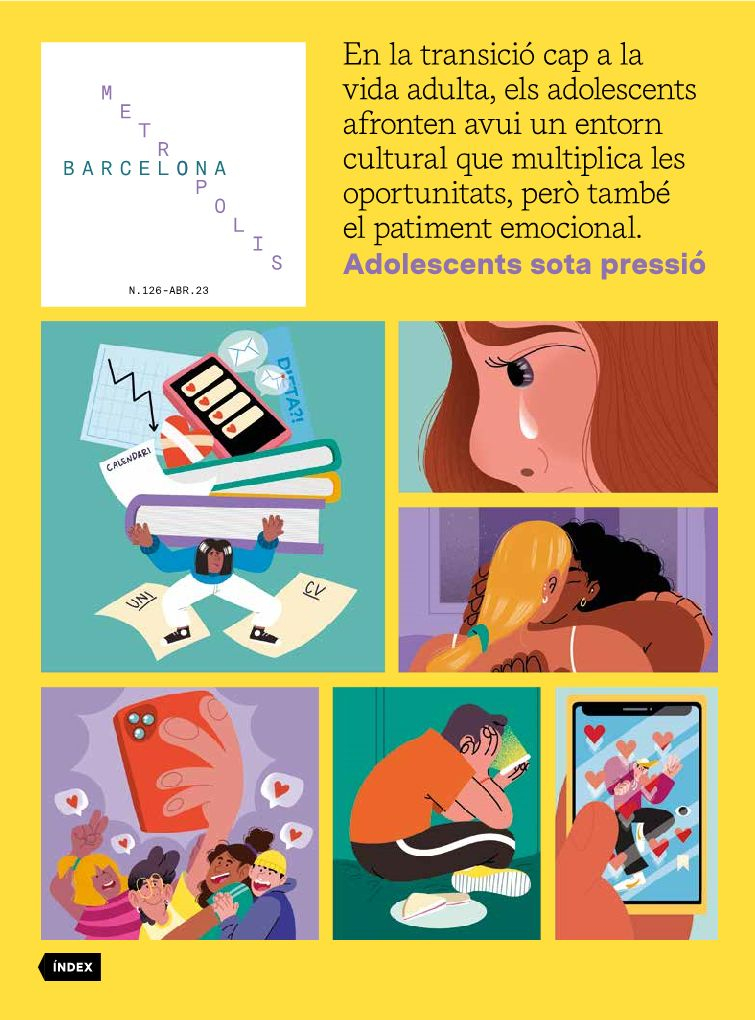Wellbeing and resilience building for healthy growth
- Dossier
- Apr 23
- 7 mins

To understand the reasons behind the mental disorders pandemic suffered by young people and adolescents, global and long-term environmental causes need to be considered. Healthy growth calls for a society that provides wellbeing, but also one that facilitates learning and the capacity to handle small setbacks and frustrations as daily practice to cope with the constant challenges that life presents.
In the wake of the Covid-19 pandemic has come the emotional malaise and mental disorders pandemic. Mental health has made headlines, television and radio programmes, and have even sparked student demonstrations over the last few months. The conventional invisibility of mental health problems was apparently coming to an end. Besides the attention of the press, audiovisual media and social media, institutions have also taken a stance, with the Government of Catalonia expressly stating that mental disorders should be addressed as a healthcare priority. Greater social awareness has been raised and, overall, a reality that has been hidden and denied for many years has been brought into the open. This constitutes a huge step forward for many people as individuals, but also as a society.
Nevertheless, it is also true that, while all this has been under discussion, what are medically considered serious illnesses or mental disorders have been lumped together with what are emotional upsets or difficulties in coping with adversity. This lumping together can lead to confusion and can divert us away from the specific help that people need in each case.
Being able to talk openly and to underline the fact that mental disorders exist, that they can be very serious and even debilitating, and that we must be able to talk about them freely, to really overcome the stigma, and to find new ways to treat them and integrate them into our lives and daily lives, is of the utmost importance. Equally important is being able to talk about emotional distress, especially in adolescents, which has grown in recent months and takes many different forms: worry, bullying, anxiety, sadness, self-harm, suicidal thoughts…
Although some of these disorders can develop into mental illnesses, most of them, especially in the early stages, should be approached from a medical and social point of view as malaise. Undeniably, there is a growing malaise among young people, and the ways in which this malaise manifests itself are also changing. This development should challenge us all, both individually and collectively, precisely to prevent it from escalating into serious pathologies.
The causes behind the malaise
When reflecting on what could be the root cause of the malaise and the rise in disorders among today’s adolescents and young people, and coming under the umbrella of the biopsychosocial model, which conceptualises mental health as a balance between biological, psychological and socio-environmental factors, we need to ascertain what factors, which have recently changed, may be responsible for or contribute to mental malaise. There are many sociological and even anthropological factors that are not my field of expertise, and therefore I will not explore them here. The idea behind this article is rather to think about the factors inherent to mental health.
If we were to follow the above argument, it does not seem likely that this increase in malaise and disorders can be attributed to genetic causes, since we know that genetic changes are caused by mutations accumulated over generations, and an abrupt change in pattern such as the one observed does not fit this model. Nor would it seem appropriate to attribute it to psychological causes linked to each individual’s psychological make-up, because here the individual factor is very important and, in contrast, the phenomenon we are talking about is much more widespread. If we conclude that neither genetics/biology nor psychology can explain it, we will have to consider the social and environmental context, and think about which of the changes that have taken place in this area may be influencing it.
 Illustration. ©Genie Espinosa
Illustration. ©Genie EspinosaMany international medical bodies are examining the effects of premature exposure to screens.
When we refer to the environment in which a person develops, it is not a factor that can easily be described; environmental factors that affect individuals and more widespread or collective environmental circumstances must be taken into account. We know from studies carried out in recent years that having suffered a major traumatic event at some point in life can profoundly affect brain structures and emotional control systems, and thus lead to the onset of mental disorders. But traumatic events are, apart from exceptional events (wars, disasters, etc.), individual circumstances, and the event in question is a phenomenon of a much more general nature and is not related to a collective trauma. We will therefore have to think of more global environmental causes, of a prolonged duration, with the capacity to affect children and young people in later years.
How to cope with adversity
We need to determine the kind of relationship model promoted by families and society, as well as the listening skills among the members of these families in relation to others and also towards strangers. It may also be necessary to reflect on what forms of entertainment are encouraged in leisure time and where they are sought.
By way of example, many international medical bodies are examining the effects of premature exposure to screens, which have entered our lives and those of our children without us knowing in advance whether or not they might prove detrimental to their development. We need to measure everything we stop doing because of the space screens have taken up: all the one-to-one conversations we stop having, the games we stop playing, the coping skills in an argument we stop having because of lack of practice... We have to consider the impact of everything that, especially in the case of adolescents and young people, is no longer being experienced in real life.
Social, personal and educational models that strengthen resilience and help children and young people to cope with adversity should be encouraged.
Because, to enable them to cope with adversity fairly well, to adapt and move on, an environment is needed that fosters all these values in children and young people. It is not only about having a society that provides wellbeing – which is essential for healthy growth – but also one that facilitates learning and the capacity to handle small setbacks and frustrations as daily practice to cope with the constant challenges that life presents, as it has always has and always will.
We are aware of a number of factors that are key to being able to withstand adversity and to having good mental health, such as the capacity for introspection, solidarity, assertiveness and the ability to concentrate on the moment and to think about the meaning and the path our life is taking. It also requires the tools to be able to express one’s opinions and to have a responsible attitude towards others. These factors are the pillars that underpin a concept called resilience, which is defined as the ability to adapt adequately to adversity. This concept comes from the physics of materials, which considers resilience to be the ability of a material to return to its original position after being bent or stretched.
Many of these capacities or qualities have been nurtured in people’s education and training intuitively and naturally in many societies and traditions. Most cultures and social organisations have valued and enhanced solidarity and their structure incorporates spaces for spirituality, transcendence and responsible decision-making, necessary for the common good and for acceptance as members of the group. Admittedly, changes in technology and culture have driven us away from some of these practices; they may need to be revived, enhanced and even practised if we are to regain the capacity to adapt to the environment that we should inherently have.
Just as we have experienced the digital transformation, perhaps we need to undergo a small relationship transformation and commit to social, personal and educational models that strengthen resilience, and help children and young people to tackle adversity and difficulties as challenges, with fully-fledged capacities. Everyone’s mental health will reap the benefits of these efforts.
The newsletter
Subscribe to our newsletter to keep up to date with Barcelona Metròpolis' new developments




